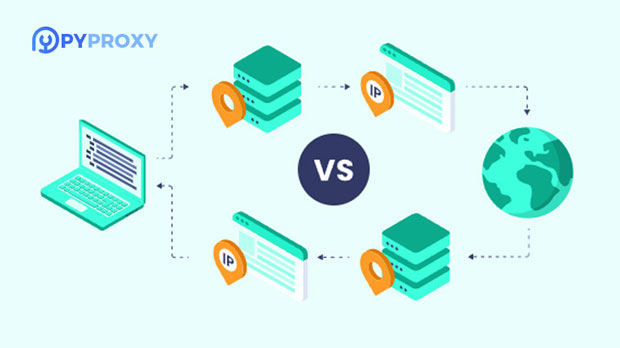When discussing the functionality of socks5 proxy checkers, an essential question arises: Do these tools support multi-protocol testing? socks5 proxies are widely used for their flexibility and efficiency in handling various types of internet traffic. However, the question of whether a SOCKS5 proxy checker can effectively test multiple protocols often goes unanswered. In this article, we will delve into the capabilities of SOCKS5 proxy checkers, explore their role in multi-protocol testing, and analyze their practical implications for users. By the end, you will have a clear understanding of how SOCKS5 proxy checkers work, and whether they are sufficient for testing multiple protocols, such as HTTP, HTTPS, and even more advanced ones. 1. Understanding SOCKS5 Proxy CheckersTo understand how SOCKS5 proxy checkers function, it's important to first grasp what a SOCKS5 proxy is. SOCKS5 is the fifth version of the SOCKS protocol, designed to handle requests for data through a proxy server, offering greater versatility than its predecessors. It supports a wide range of protocols, including TCP and UDP, and is frequently used for activities that require privacy, security, and anonymity.A SOCKS5 proxy checker, as the name suggests, is a tool designed to verify the functionality and performance of a SOCKS5 proxy. These checkers perform a variety of tasks, such as verifying the proxy's IP address, checking for leaks, and ensuring it is properly configured. Some advanced checkers even test the proxy's ability to handle different types of internet protocols, providing a comprehensive evaluation of the proxy's performance.2. The Role of Multi-Protocol TestingMulti-protocol testing refers to the ability to evaluate a proxy’s performance across different types of internet traffic. For instance, a single proxy might be tasked with handling HTTP, HTTPS, FTP, or other protocols. When testing proxies, especially those used for security purposes, it is crucial to check how well they support these diverse protocols.While SOCKS5 itself supports a range of protocols, the true question is whether a SOCKS5 proxy checker is equipped to test all these protocols. In practice, the ability to perform multi-protocol testing can determine the usability and versatility of a proxy in various scenarios, from web browsing to file transfers and beyond.3. Key Features of a SOCKS5 Proxy Checker for Multi-Protocol TestingA robust SOCKS5 proxy checker should be able to evaluate not just the basic functionality of the proxy but also its performance across multiple protocols. Some of the key features to look for when testing multi-protocol support include:- Protocol Compatibility: A quality checker should determine whether the proxy can handle not just SOCKS5 traffic but also other protocols like HTTP, HTTPS, FTP, and UDP. This is crucial for users who require the proxy to perform a wide range of tasks. - Traffic Handling: The ability of the proxy to handle different types of traffic—such as encrypted HTTP (HTTPS) and unencrypted HTTP (HTTP)—is critical for security-conscious users. A proxy that cannot properly route HTTPS traffic is a significant limitation.- Speed and Performance: Multi-protocol testing should also involve assessing how the proxy handles different types of traffic under varying network conditions. This includes measuring latency, throughput, and data transfer speeds across different protocols.- Leak Protection: A reliable SOCKS5 proxy checker should test for potential leaks, such as DNS leaks or WebRTC leaks, that can compromise the user's anonymity and privacy, especially when using multiple protocols.4. Can SOCKS5 Proxy Checkers Handle Multi-Protocol Testing Effectively?The effectiveness of SOCKS5 proxy checkers in testing multiple protocols largely depends on the tool itself. While some SOCKS5 proxy checkers are specifically designed to handle multi-protocol testing, others might only be able to test basic functionality or check specific aspects of the SOCKS5 protocol, such as IP address validity or connection speed.Here are some insights into how well SOCKS5 proxy checkers can handle multi-protocol testing:- Limited Protocol Support: Many SOCKS5 proxy checkers are designed primarily to check the SOCKS5 protocol itself, focusing on verifying the connection’s functionality and stability. These tools might not be equipped to test other protocols like HTTP or FTP, which could be a limitation for users looking for a comprehensive evaluation.- Advanced Checkers: More advanced SOCKS5 proxy checkers, however, offer more extensive testing, including multi-protocol testing capabilities. These tools typically allow users to specify the type of traffic they want to test (e.g., HTTP, HTTPS, FTP, etc.) and provide detailed reports on how the proxy performs across these protocols. However, such tools tend to be more complex and may require more technical expertise.- Proxy-Specific Limitations: Even if the checker supports multi-protocol testing, the underlying proxy may have limitations. For instance, while SOCKS5 supports a wide range of protocols, some proxy servers may not be properly configured to handle certain types of traffic or may have restricted capabilities. It’s important to recognize that the performance of the proxy itself will play a significant role in the test results.5. Practical Implications for UsersFor users who rely on SOCKS5 proxies for privacy and security, understanding how these proxies perform with various protocols is vital. Here are some practical implications for users to consider:- Comprehensive Security: If you use a proxy for secure activities such as online banking or shopping, multi-protocol testing ensures that your traffic remains secure, whether it’s HTTP, HTTPS, or another protocol. A failure to handle HTTPS properly, for instance, could expose you to man-in-the-middle attacks.- Performance Considerations: Users who need to transfer large files or stream media will benefit from testing a proxy’s performance across multiple protocols. For instance, FTP and UDP traffic can require significantly different bandwidth and handling, so ensuring that a proxy performs well under these conditions is crucial.- Reliability in Multiple Environments: Multi-protocol testing is especially useful for users operating in diverse network environments. For example, users in different countries or with different ISPs may experience varying degrees of proxy performance. Multi-protocol testing allows users to understand how the proxy performs in various scenarios, ensuring it remains reliable under different conditions.6. ConclusionSOCKS5 proxy checkers can, in theory, support multi-protocol testing, but the level of support varies widely depending on the tool and its features. While basic SOCKS5 proxy checkers are limited to testing only the SOCKS5 protocol itself, advanced checkers do offer multi-protocol testing capabilities that can assess the proxy’s performance across a range of internet traffic types.For users who rely on SOCKS5 proxies for security, privacy, and performance, understanding how these proxies handle different protocols is vital. A comprehensive checker that tests multiple protocols can provide valuable insights, ensuring that your proxy is functioning optimally in a variety of scenarios. Therefore, when selecting a SOCKS5 proxy checker, it’s crucial to choose one that meets your specific needs and provides an in-depth evaluation of the proxy’s capabilities across multiple protocols.
Dec 25, 2024
![arrow]()



















































